Fascinating history, brilliant architecture and some rather interesting stories made Brihadeeswarar Temple (Brihadeshwara Temple) or the Big Temple of Thanjavur (Tanjore) one of my most favourite places in Tamil Nadu. That I am so fond of ancient architecture and ruins are is perhaps known to all my friends and closed ones. And if the place has so many interesting tales surrounding it, my itchy feet would not rest before I visited Brihadeeswarar Temple in Thanjavur.
Did you know? The shadow of the Vimana (the temple tower) does not appear on the ground at noon.
There are many such interesting and intriguing facts about the Big Temple, one of the oldest temples in India, also known as the Living Chola Temples. It is said that there are more than a hundred underground passages in the Brihadeeswarar Temple that connect to various places. Dedicated to Lord Shiva, the Big Temple of Tanjore is not just any religious place. The temple is considered to be a marvel in temple architecture and construction and is a testimony to the might of Raja Chola Chola I of the Chola dynasty, something that the great king himself wanted.

My visit to Brihadeeswarar temple was done after a lot of manipulations. I was in Chennai and was scheduled to visit Mahabalipuram and had 2 days to spare. While I was tempted to give Pondicherry another visit, Thanjavur seemed to beckon me. A quick internet search helped me with my decision. The photographs of the Brihadeeswarar Temple were enough to convince me to visit Tanjore. My third visit to Pondicherry had to wait! After our visit to Hampi the month before, I was fascinated towards the architectural wonders and I was totally enamoured by the Big Temple.
I reached Trichy Bus Stand early in the morning and from there took a bus to Thanjavur. Although communicating with the bus conductors in the local language was a bit problem, but he seemed to understand that I was looking for the Big Temple. He dropped me at the correct location and then Google Maps helped me reach my destination.

What is the Brihadeshwara Temple or the Big Temple of Thanjavur (Tanjore)?
The Brihadeshwara Temple or the Big Temple as it is fondly called is a symbol of the power and might of the ruler of the Chola Dynasty. The temple was built by Raja Raja Chola I of the Chola Dynasty in the year 1010 AD. The Brihadeeswarar Temple is known as Peruvudaiyar Koyil (Big Temple) locally. During the reign of the Cholas, the temple was known as Rajarajeswaram. Later when the Marathas invaded the land and added other structures to the temple, it came to be known as the Brihadeeswarar Temple. The temple is now a UNESCO World Heritage Site and also one of the most important destinations of South India.

History of the Brihadeshwara Temple | The reign of the Chola Kings
The Brihadeshwara Temple was built in the 11th century during the time of the famous Raja Raja Chola. The Cholas were said to be the longest-ruling dynasties in the southern region of India. During the Chola rule, art and architecture flourished in the region like never before. The temples and the literature of this period bear testimony to this fact.
The reign of the Cholas began in the 9th century when they defeated the Pallavas and came to power. They ruled for a long time of five centuries till the 13th century until the arrival of the Pandyas. Vijayalaya was said to be the founder of the Chola Empire when he took over Tanjore by defeating the Pallavas in the 8th century. Tanjore was thus the first capital of the Chola Empire.
The golden period of the Cholas is said to be under King Arunmozhi Varman. Under him, the Chola empire expanded in all directions and he was eulogized as the “Lion among the Kings” and Raja Raja Chola. The king’s territory extended up to Kalinga (modern-day Odisha) and Ezham (Sri Lanka) and Lakshadweep. His trade and military exploits took him to various parts of this country and beyond. The influence of the Chola Empire was evident even in the eastern parts of India as well as in the Southeast Asian countries like Indonesia and Malaysia. It is believed that the vision of the temple came to the King in his dreams while visiting Ceylon (Sri Lanka). I am not so sure about the dreamy intervention, but I think the King must have had seen many grand temples while in his exploits in Ceylon and desire to build a massive temple dedicated to his favourite deity Lord Shiva. The King’s vision was to build a temple in honour of his great kingdom, a temple that would be as grand and magnificent as his empire was. Thus the thought of the grand temple was born.
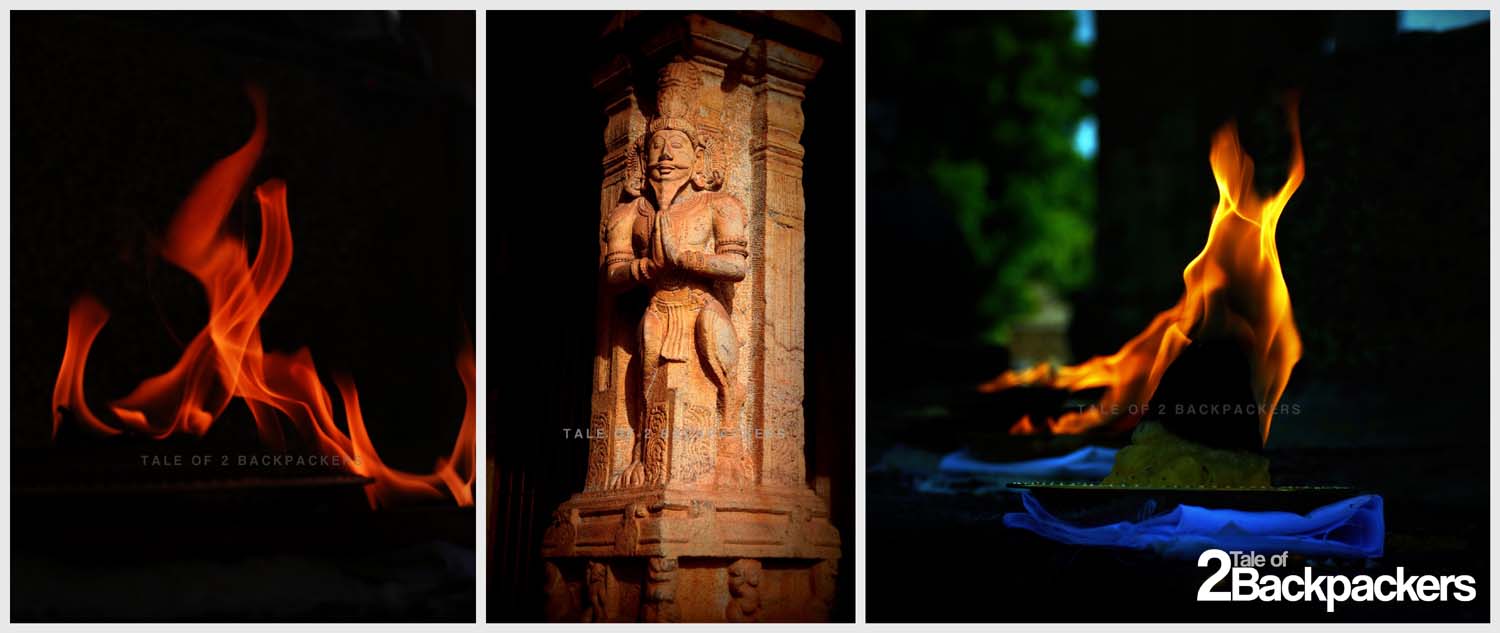
The Brihadeshwara Temple was indeed built to display the power and might of the king to the world. The temple built entirely of granite and has a height of almost 216 feet at its highest point definitely realized the King’s dream. The temple was the site of major royal ceremonies and daily rituals towards the deities. This 1000-year-old temple still stands as a witness to the might of the Chola emperor. The complex has not one temple, but many other smaller shrines consecrated by the rulers of other dynasties also. But the jewel in the crown is the main central Temple.
What are the unusual facts and myths about the Brihadeshwara Temple?
An engineering marvel, a fascinating form of Dravidian architecture – all these paeans have been attributed to the Big Temple of Thanjavur. And if you do not visit the temple, you will not really understand why such praises are heaped on it. According to the inscriptions found in the temple, the engineer and architect behind this great structure were Kunjara Mallan Raja Raja Perumthachan.
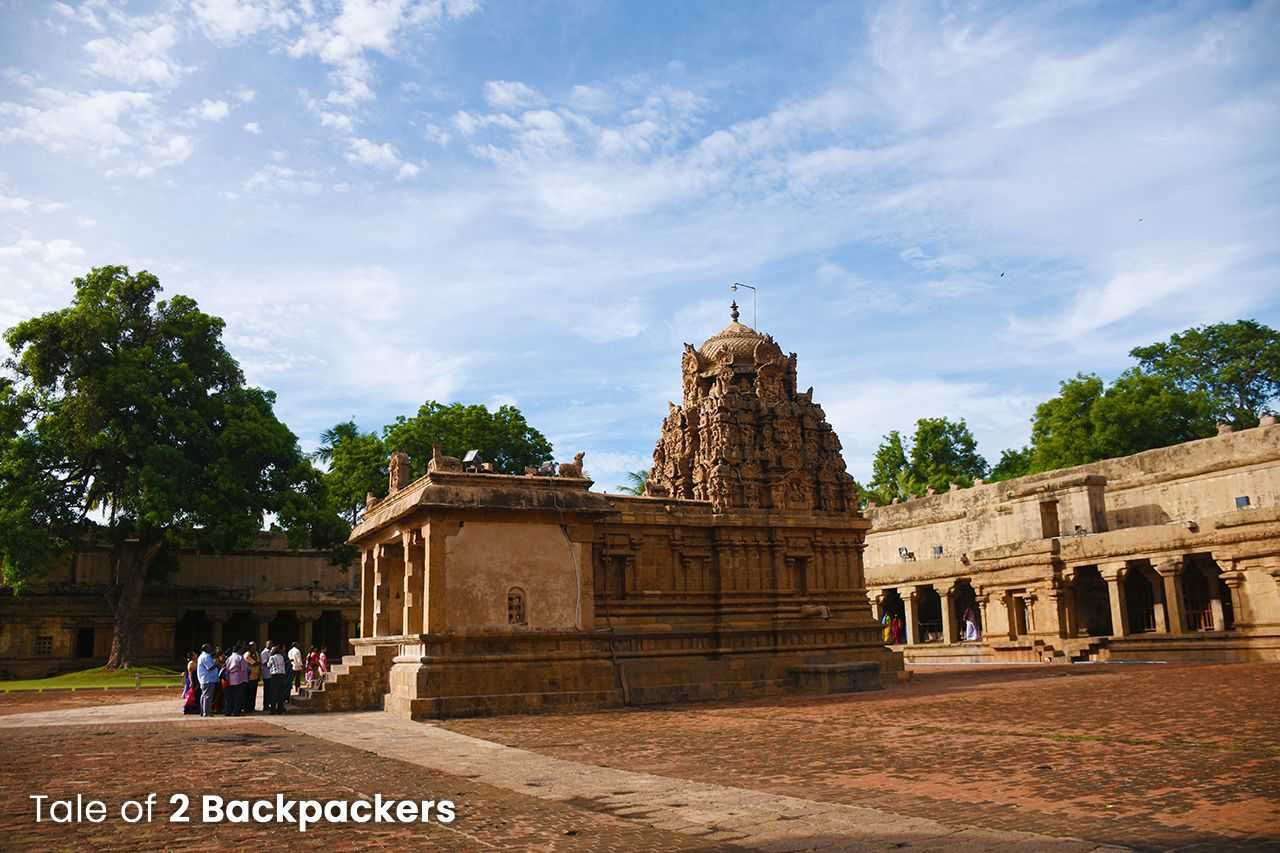
While a look at the temple is definitely awe-inspiring in terms of architecture and design, there are a few intriguing facts and mysterious stories about the temple. The guides at the temple would readily share these stories with you, some of which were pretty interesting. Here are a few facts about the Brihadeshwara Temple or the Big Temple of Thanjavur. Whether they are unusual or not, that is for you to decide.

- You don’t see the shadow of the Vimana of the temple at noon.
This is an interesting fact about the Brihadeshwara Temple and the guide will definitely tell you that this is the only temple to have this peculiar character. You will not see the shadow of the Vimana or topmost structure of the temple fall on ground at noon, no matter at what season you visit But actually, the temple does cast a shadow, but it creates an impression that it does not. The tower is built in a cascading style. The shadow on the top falls on successive layers of stone resulting in an illusion that the tower does not cast any shadow.
- The entire temple is made of granite.
The entire temple is made up of granite stones. Historical evidence shows that there were no granite cutting quarry or granite sources around 50 km of Thanjavur. The massive sized stones used to build the temple must have been brought from somewhere far away. Just imagine how they must have brought those heavy stones to the temple site. However, it is believed that elephants were used to pull the granite blocks to the temple site. It is said that 130,000 tonnes of granite was used to build the temple!
- The main Vimana of the temple is 66 m or 216 feet high.
The main Vimana (the temple tower) built above the sanctum measures 66 m or 216 feet in height. This was said to be one of the tallest structures in South India during those days. There is a large octagonal capstone or Kumbam at the top of the Vimana that weighs a whopping 80 tons.
At the top of the Vimana near the capstone, there are 8 structures of Nandi facing the 4 cardinal directions.
It is also quite a wonder as to how the heavy stones were lifted and placed at the top of the high temple. The guide told me about the theory where sages chanted Vedic mantras to levitate the stones to the top of the tower! He also told me that it was also possible that basic engineering like the inclined plane and massive rollers were used to lift the stone with the aid of men with ropes.

- There are hundreds of underground passages in the temple complex.
It is said that there are more than a hundred underground passages that connected to the King’s palace and various other places. In earlier days, it was said that the kings, queens used these passages to move around. Nowadays, most of these passages are sealed.
- The statue of Nandi at the temple is carved out of a single stone.
With every Shiva Temple, there has to be a structure of Nandi. Here too, the structure of Nandi was in front of the temple. The structure of Nandi carved out of a single stone measure 16 feet long and 13 feet high weighs around 20 tonnes and is the second-largest sculpture of Nandi in India.
- The Shiva Linga inside the temple sanctum is 3.7 metres tall.
- The Brihadeshwara Temple is also one of the few temples that have Ashtadikpala idols (Guardians of the eight directions). Chola frescoes are found on the ceilings and the walls. These frescoes are exquisite and depict Shiva in different forms.
- There are elaborate paintings and frescoes on the walls of the temple depicting Lord Shiva and other important events of those times. Most of these paintings are of bright colours and stand out against the stark granite structure.

- There are a number of detailed inscriptions in the Brihadeshwara temple. It is believed that these inscriptions contained details of the daily rituals of the temple, offerings to be made and other crucial information regarding the administration of the temple. I did see some inscriptions on the temple walls that I obviously did not understand. It could have been that they contain all those information!

Structures at the Brihaddeswarar Temple or the Big Temple of Tanjore
There are as many as 15 structures and shrines inside the Brihadeshwara Temple complex. All of these structures were not built by the emperor Raja Raja Chola I. The Chandikeshvara shrine was built by the Nayak’s in the 16th century and the Subrahmanya Shrine was also built by them in the 17th Century. Maratha ruler Serfoji had also added to the temple complex. The Nataraja Mandapam was built by the Maratha ruler Serfoji II in 1800 AD and the Amman shrine was probably built by the Pandyas around the 13th Century.

List of structures at the Brihadeeswarar Temple or the Big Temple of Tanjore
- Maratha Entrance
- Keralantakan Tiruvasal
- Rajarajan Tiruvasal
- Nandi Mandapam
- Varahi Shrine
- South Cloister Mandapam
- Brihadeshwara main temple
- Interpretation Centre
- Ganesha Shrine
- Karuvur Devar Shrine
- Chandikesvara Shrine
- North Cloister Mandapam
- Amman Shrine
- Nataraja Mandapam
What is Maratha entrance?
This is the first gate that you will come across while entering the temple complex. This gate was built during the reign of the Maratha rule in this region. This is the simplest gate with a Gopuram on top. But the gate is extended surrounding the temple. Most probably, the Maratha Gate served as a wall of defence as the remnants of a moat could be seen surrounding the wall.

Keralantakan Tiruvasal | Brihadeeswarar Temple
This is the second gate or Gopura after you cross the Maratha Entrance. This structure is a classic example of Chola architecture. This gate was built to celebrate the victory of King Raja Raja Chola over the Cheras.
The gateway is named after his favourite sobriquet Keralantakan (destroyer of Kerala, the kingdom of the Cheras).
The gate has carved figures of Hindu Gods and Goddesses like Shiva, Parvati, Ganesha and Vishnu. The carvings are elaborate and you definitely have to spend some time to see them.

Just behind the Keralantakan Tiruvasal is the shoe stand where you can keep your shoes and other belongings. I kept my heavy backpack there while I entered inside the complex with my daypack.
Rajarajan Tiruvasal | Brihadeeswarar Temple
This is the third and final gateway before you enter the temple complex. This is the most ornate and beautiful of the three, fit to be the Gate of the King. The gate has intricate carvings on three distinct tiers. There are two stone guards or Dwarpalika flanking the arched entrance-way. This gate mainly had carvings from the life of Shiva like the marriage of Shiva-Parvati, Arjuna winning the Pashupati Astra (a divine weapon) from Lord Shiva.

Even from the gate, I could see what was inside. The structure of the Nandi, the bull loomed in front and beyond that I got a glimpse of the huge Vimana.
Nandi Mandapam | Brihadeeswarar Temple
After Rajarajan Tiruvasal, you would have entered the main temple complex. Where there is Shiva, Nandi will also be present. For the uninitiated, Nandi, the bull is Shiva’s guardian, companion as well as his mount. Every Hindu temple that is dedicated to Lord Shiva will have an idol of Nandi bull facing the shrine of Lord Shiva.

As you enter the temple complex, you will notice the raised platform on which the idol of Nandi was placed. The Nandi idol was built around the 16th– 17th century by the Nayaks. You can climb up on the platform. There are some beautiful and colourful paintings on the ceiling. These paintings are said to be from the time of the Nayaks and the Marathas. Also, have a look at the intricately carved pillars having some mythical creatures. As you climb down the Nandi Mandapam, there is an old oil lamp where ladies were offering prayers. As I had mentioned before, the idol of Nandi was carved out of a single stone and is 16 feet long and 13 feet high weighing about 20 tons.
Brihadeshwara (Brihadeeswarar) Temple main shrine
As you follow the gaze of Nandi, you will see the most important and impressive structure in the complex. Just across the courtyard stands the Big Temple of Tanjore, compared to which all the structures seem dwarf in size. The courtyard is huge and was said to be used for religious gatherings as well as community gatherings.

Photography is not allowed inside the temple. As I entered the temple, I got a glimpse of the huge Shivalinga. And the next thing I noticed was the cold stone beneath my feet. I had visited during the month of September and all these time I was roaming around the complex where my feet scorched due to the heat. But inside the temple, it was cold. Inside the temple, you will see the painting of Raja Raja Chola with his Guru Karuvurdevar as well as other paintings from the Chola period. Inside the Garbha Griha or main sanctum where the Shiva linga is placed, only the priests are allowed to enter.
As you come out of the Vimana, you will see other shrines across the complex. But whatever you do, spend an adequate amount of time to see and explore the main temple. It is a huge structure having magnificent carvings. The outer walls of the temple or the façade are full of exquisite carvings mostly from the Hindu mythology.

What is most interesting in these carvings is the presence of a person wearing a hat. It looks like a European person at first sight. What a European person would do among the Hindu pantheons is actually a mystery, which even the guides do not seem to have a plausible explanation. The carving clearly shows the image of a man wearing a hat and something like a shirt. Perhaps the Cholas had trading relations with the Europeans even before it has been recorded in history. Or perhaps he was someone that King or sculptor must have seen during their foreign journeys! All these are speculations on my part. Didn’t I tell you that old stones and ruins make my imagination run wild! Unfortunately, I do not have the picture to show you., but you can do an internet search about it.

Cloister Mandapam at Brihadeeswarar Temple
Just as you come out of the main temple, you will see that the boundary of the temple has a corridor-like structure. This is the Cloister Mandapam that contains several smaller shrines. The northern cloister Mandapam was built by Krishnan Raman, the military commander of King Raja Raja Chola. There are several shrines in the Cloister Mandapam. Later the Maratha ruler Sarabhoji installed 108 Shiva Lingas in this place. Apart from the shrines, the Cloister Mandapam also has some beautiful ancient murals and paintings.

Ganesha Shrine
Just behind the Brihadeshwara Temple, stands the Ganesha Temple. The Ganesha shrine is a small structure built by the Maratha ruler Sarabhoji in the late 18th century. Ganesha is the chief deity of the Marathas.

Karuvur Devar Shrine
Behind the Brihadeeswara Temple, on the right stands the Karuvur Devar Shrine. The shrine is dedicated to Karuvur Devar, the guide and teacher of Raja Raja Chola. Just like the Ganesha Shrine, this one is also a small one.
Chandikeswara Shrine
The Chandikeswara Shrine stands to the immediate right of the Brihadeeswarar Temple. This is the only remaining shrine that the Raja Raja planned and built in the vast courtyard. This shrine is also a classic example of Chola architecture.
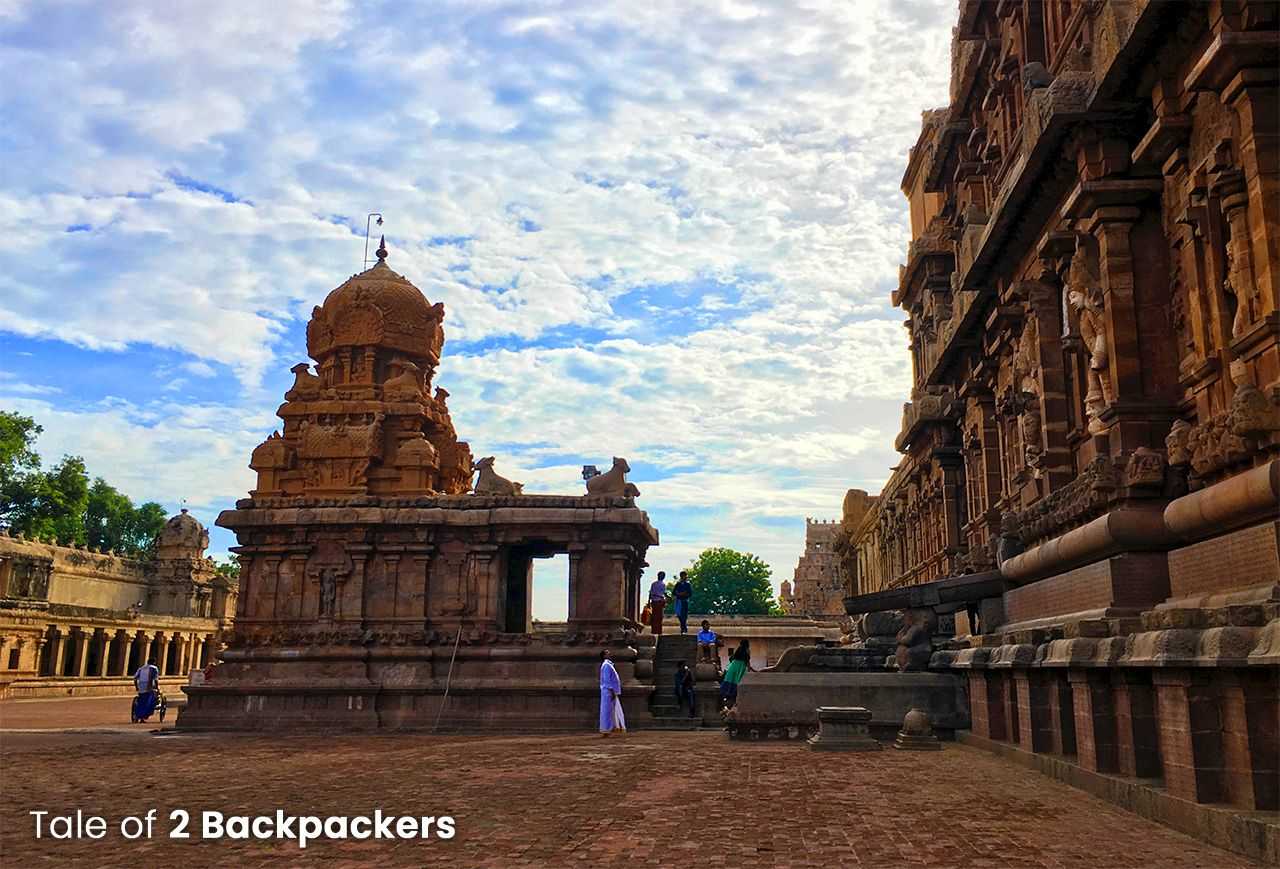
Subrahmanya Shrine
Next to the Chandikesvara Shrine is the Subrahmanya Shrine built by the Nayak rulers in the 16th-17th century. This structure is one of the best examples of Nayak architecture. This shrine had two sections, the first one a flat roof section and the second one a gopuram. The staircase of the shrine is particularly beautiful.

Ammam Shrine
The Ammam Shrine is dedicated to Goddess Parvati, Lord Ganesha’s mother and Lord Shiva’s consort. Ammam shrine literally means the Mother’s shrine and is located on the right ahnd side of the Rajarajan Tiruvasal entrance. This shrine has some really beautiful carvings and murals. This structure was the first addition in the courtyard after Raja Raja’s. This was built in the 13th century by a Pandyan King. The Mandapa in the front was later added by the Maratha ruler during the 17th century. This is a great example of Pandyan architecture in the Chola kingdom.

Nataraja Mandapam
This is right next to the Nandi Mandapam and has an idol of Nataraja, or the dancing Shiva.
Why should you visit the Brihadeeswarar Temple or Thanjavur Big Temple?
- Simply because it is one of the best examples of Dravidian architecture. The entire temple complex is the mélange of the best of Chola, Nayak, Pandya architecture. It is also the largest temple of its kind in the country. The temple is full of intricate stucco works depicting various figurines of Gods and Goddesses as well as other figures.
- If history and heritage is your thing, then a visit to this UNESCO world heritage site is a must.
- The Nandi idol in front of the main temple is the second largest in India.
- There are many high quality and beautiful paintings in the Big Temple that depicts a lot about the life of the King Raja Raja Chola I.
- The frescoes and murals at the ceilings of the temple are also of very high quality.

How to reach the Brihadeshwara Temple or the Thanjavur Big Temple?
The Brihadeshwara Temple is located at Thanjavur, also known as Tanjore. The best way to visit Thanjavur is to take an overnight bus from Chennai. Distance from Chennai to Thanjavur is 341 km by road.
The nearest airport is at Trichy. You can also arrive at Trichy by train or bus from Chennai and then travel further to Thanjavur.
I had taken an overnight bus to Trichy, reached the Trichy Central bus stop at 5:00 AM, and then took a local bus to Thanjavur. The local buses usually drop at the New Bus Stand. From the new Bus Stand, I took another local bus that dropped me near the Old Bus Stand, and from there I walked my way to the temple. You can also take an auto to the Big Temple. An auto will take around 80-100 INR, but you have to bargain hard.

What is the best time to visit the Brihadeeswarar Temple (Thanjavur Big Temple)?
Winter seasons are the best time to visit. As the summers in the southern part of India are quite hot, it becomes difficult to roam around the temple complex. Also, try to visit the temple early in the morning or in the late afternoon. At noon, the place becomes quite hot and you have to walk barefoot in the temple complex.
Bathing of Nandi is a ritual that takes place here every 15 days. This is also a spectacle to watch.
What are the places to stay at Thanjavur?
Thanjavur has some decent hotels where you can stay. You can also stay at Trichy which is a bigger town and have better accommodation options. The distance from Trichy to Thanjavur is around 57 km and takes around an hour.
Some useful tips
- Wear light and comfortable clothes.
- I would recommend you to wear socks. You are not allowed to enter the temple complex with shoes on and during the day, the ground becomes really hot. I walked barefoot and my soles were roasted by the morning heat.
- Carry your water bottle. Believe me, you will need it.
- Visit the temple early in the morning or in the late afternoon to avoid the scorching heat.
- Photography is prohibited inside the main temple and the Ammam Shrine.
- There is no entry fee for the Brihadeshwara Temple of Thanjavur.

Other Places that you can visit in Thanjavur
Well, the Thanjavur Big Temple or Brihadeshwara Temple is not the only attraction in Thanjavur. Here are some other places that you must visit while in Thanjavur (Tanjore).
- Thanjavur Palace
This is another important attraction of Thanjavur town. This palace was initially built by the Nayak rulers but was later taken over by the Marathas after they defeated the Nayaks. The Marathas later built a modern palace which was also the residence of the Bhonsle family between 1674-1855. The Thanjavur Palace consists of a complex of different structures. Inside the palace are different museums where rare collectables are displayed. My favourite, however, was the Durbar Hall whose ceiling is very beautifully and colourfully painted. The paintings on the ceiling are somewhat close to that in the Nandi Mandap of the Brihadeshwara Temple.


- Punnainallur Mariamman Temple
This temple was built by the Maratha King of Thanjavur Venkoji in 1680. The temple is located about 5 km from Thanjavur town and you can take an auto to visit the temple. The King had received a divine intervention from the Goddess Muthu Mari Amman to build the temple. He was instructed that he would find the idol of the Goddess in the forest. He indeed found the idol under a Punnai tree.
- Thanjavur Dolls
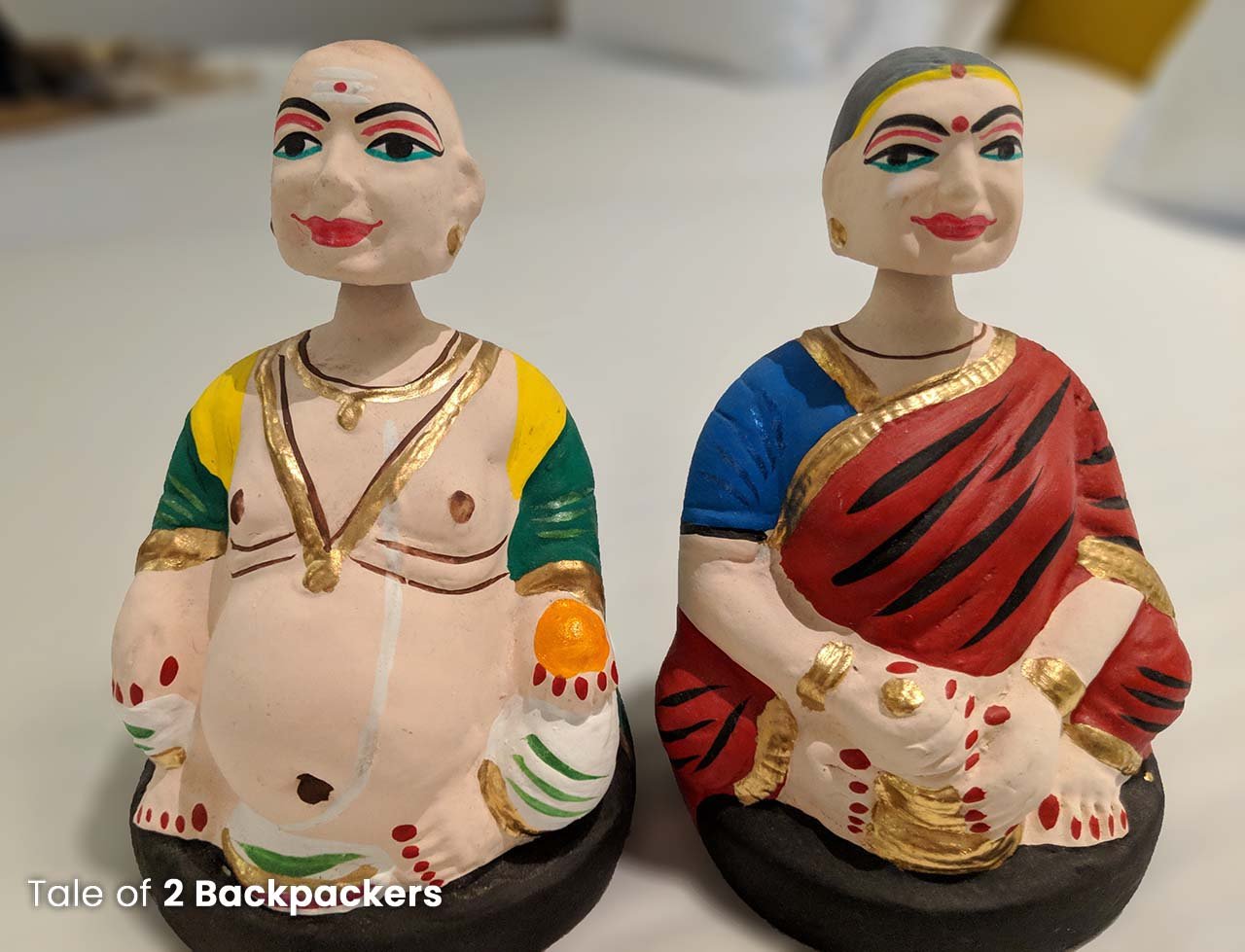
Thanjavur dolls are one of the oldest and traditional handmade dolls. Traditionally known as Thanjavur Thalaiyatti Bommai, these dolls form an eclectic part of the heritage of Tanjore. Their history is linked with the history of the region dating back to the 19th century during the reign of King Sarabhoji. The peculiarity of these dolls is that they have bobblehead that shakes and oscillates giving the impression that they are dancing. At Thanjavur, you will find a number of shops that sells such dolls. The dolls usually come in pair, but you will find single ones also.

I took almost an hour to roam around the temple complex, look at the sculptures, relook at them and marvel at the murals and frescoes. All this time I kept on wondering the might of the ruler Raja Raja Chola I who had the vision to create something so grand. The place is also referred to as the “Great Living Chola Temples” and I think the temple is still living the life of the Chola ruler. After I came back, I realized that I might have not seen and explored the place fully. I wish to visit the Brihadeshwara Temple or the Thanjavur Big Temple again. Once is definitely not enough!
Did you like the post? Let us know your thought by commenting below. Pin this for a later read!



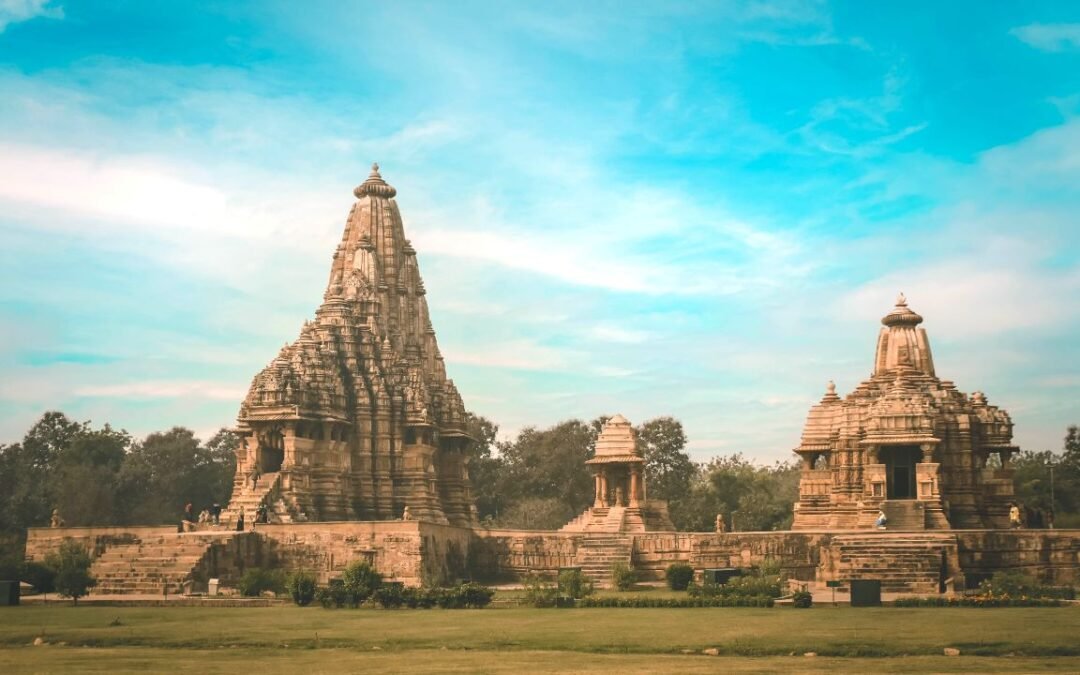




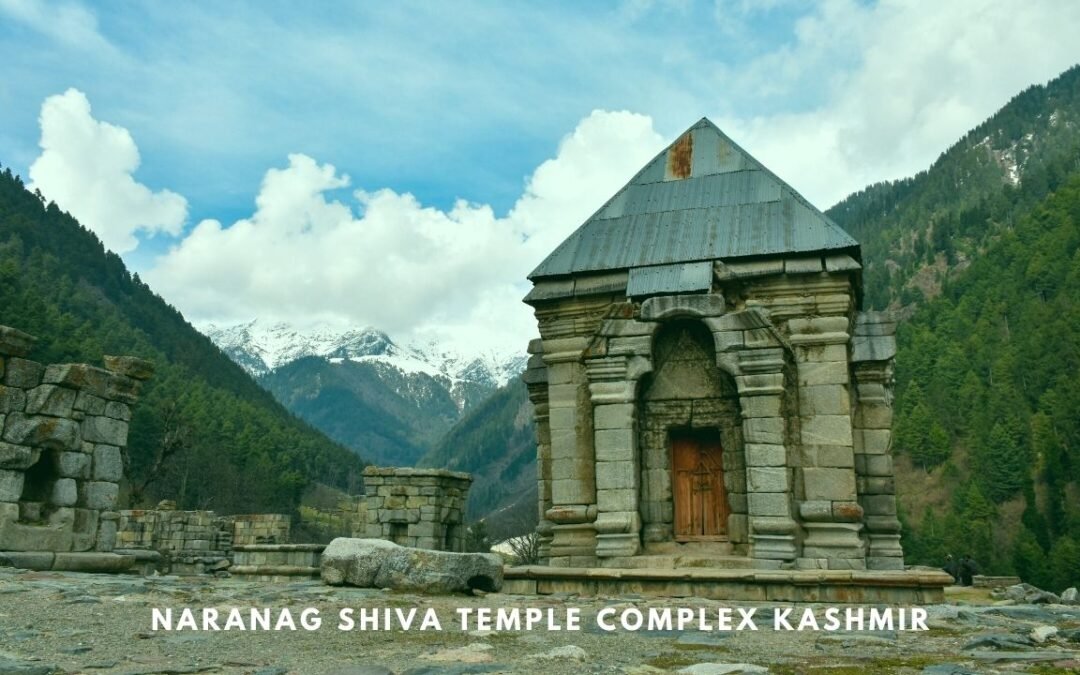

I had been there a few years ago and was blown away by the intricate architecture and just the awesome engineering feat. keep us posted for more!
I just fell in love with the pictures
I cant wait to visit India one day and get to see this in person! It blows my mind. To think they were built 1000 years ago aswell. Amazing
We’re not exactly fond of temples, but we do appreciate cultural and historical treasures. The details are just outstanding. It must have taken a lot of days, sweat, and patience to carve out or paint those images.
It feels good when you’re reading a write up about your native place. These pics ❤️❤️❤️
Thank you so much for the love. We absolutely loved the architecture of the Brihadeeswar Temple.
No words for the jaw-dropping beauty of this temple. I have also tried to share my views about the Brihadeshwara Temple. Do read my blog too.
Thank you Dhruvi! Your blog looks great as well.
I would have to agree, some of the facts about Brihadeeswar Temple are interesting, what interested me the most was the hundreds of underground passages, and the real surprise was that there is no shadow at noon of Vimana. Great tips about wearing socks in the temple, I really should do that when I visit temples in Sri Lanka, because my feet burn on the sand.
Thanks, Beverly! Yes, Brihadeeswar Temple is quite interesting.
I also love ancient architecture and really just architecture in general. Your photos show some great ones. What a fun trip!
Thank you Cynthia!
I have always wanted to visit a temple and the Big Temple looks and sounds fantastic. So much history and the architecture is outstanding! I feel for those poor elephants having to hall all of that granite! The beauty is amazing given that there were no modern day means of building, which makes it all the more interesting.
Thanks Kelly! With no machinery in those days, animals were used for these jobs. Nevertheless, the temple is really beautiful.
You make the temple come to life on the page and make me want to visit it when I can. Thank you for all the tips and advice.
Thank you Larch for the comment!
OMG so detailed narration and so interesting facts.I have seen many pictures on social media about its architecture but the facts about the temples make me want to visit here soon. Love your Post amrita.
Thank you, Mayuri!
Interesting that the levels of the Brihadeshwara Temple fall into each other at noon to actually hide some levels in the shadow of the next level. Good to know not to visit southern India in the summer too. I would probably purchase some of the Thanjavur Dolls. I have been collecting dolls from around the world since I was about 9 years old. I have a lot of dolls now.
Thanks Kathleen! Thanjavur dolls are quite pretty souvenirs to collect from India.
Wow I hadn’t heard of Brihadeeswarar Temple or Thanjavur/Tanjor before now, the complex looks very impressive. Prior to the COVID-19 outbreak, I was supposed to be in south India right now and had planned to visit Hampi. Thanjavur looks much less touristy, or at least your pics have very few people in them. Thanks for adding some extra ideas to my itinerary for when I’m eventually able to resume travel to India.
Thanks Freya! South India is quite interesting, especially Hampi. Hope you are able to visit India soon!
This was a very interesting read. You took your time to research and wrote everything in detail unlike those travel guides that only touch on how to visit and when to visit. Tanjore will be on my list when I am out of this lockdown.
Thanks Anshul!
Am I the only one noticing that this temple looks like a towering of gold when strike by the sun? It looks magnificent, and I can’t imagine the hard work, passion, and dedication in building this temple. It kinda reminds me of that sacred temple in Bangkok, where we all enter barefoot. I got lots of blisters after that visit.
Yes, now that you have said, I too think the temple does look like golden tower!
What a gorgeous temple! I am always so impressed and awed that people managed to build structures like these centuries ago. I love all the detail and stone carvings. It is so cool that they carved instructions on the walls! I would also love to see the bathing of the Nandi statue, that sounds like a very interesting ritual.
Thanks Sophie! The detailing in the carvings are really gorgeous.
Thank you for this longer post, it’s amazing how many historical details there are about this sight. Not to mention the details in these architectural wonders. I think I could be “lost” here for days admiring all of this… Pictures are great!
Thank you Dejan!
You have such amazing pictures here. They just kept me glued. So many temples in India. And so many mysteries and interesting facts behind them. I am always intrigued by these stories. And seems like the Brihadeeswar Temple in Tanjore is full of them. I am yet to visit this temple. Hopefully, soon.
Thanks Soumya! Brihadeeswar Temple has a lot of stories!
What a piece of architecture! It looks so unusual for a European eye like mine. As a travel photographer, I will be glad to hang around there and picture it in all the details.
Thank you Alex! I am sure you would love to photograph these ancient temples of India. Do visit sometime.
Brihadeeswarar Temple just looks amazing. I would like to see this place one day. I am delighted with the architecture and I suspect the atmosphere is special there. I am happy that thanks to your blog I was able to take a virtual journey to a part of the world I have never been to. Thanks!
Thank you! Brihadeeswar Temple is a special place. Everything is grand there.
Don’t miss James Smithson’s tomb just outside the north entrance of the Smithsonian Castle. After all, if it weren’t for James Smithson, there wouldn’t be a Smithsonian Institution. This is also the place to get a fantastic overview of the collections at each of the Smithsonian museums as well as chat with in-house experts to fine tune your Smithsonian plans.
True that! Thanks for sharing this. 🙂
Dear A&A,
This temple remains my favourite till date, although there are few other architectural marvels [structure wise, like Kailasa temple in Ellora which is also the single rock cut monumet till date in the world which has been vertically excavated] in our country and do know they are way more grandeur than this temple. At the same time, I think I am biased and I would vote this temple as ‘The One’ anytime. Every single time I have stepped into this temple, I had felt something different which I cannot comprehend even to myself. I enjoyed reading your version of it and I am so glad it was lucid and easy enough for a child also to read and understand the significance of the architecture. Wishing you both more travels and tales. Lots of love and safe travels.
I was there on 39th December 2022. The Visit was in the afternoon around 3:30 pm . Luckily I wore socks , so did my 2 nieces. I even had broad hat and cool glasses . Amazing Temple. We also did the other 2 temples. Gangai Konda Chozapuram by the son and Darasuram Airavatesvara temple by Grand Son. Darasuram temple is a hidden gem , with intricate carvings (almost crore according to the guide). Each of the 3 temples have their own concepts and have tried not to just copy the former but at the same time paying lots of respect to the earlier ones. Since you both are good obervers and writers I thought I will mention them . Thanks
Thank you so much for the comment. We greatly appreciate your insights. Thanks a lot.